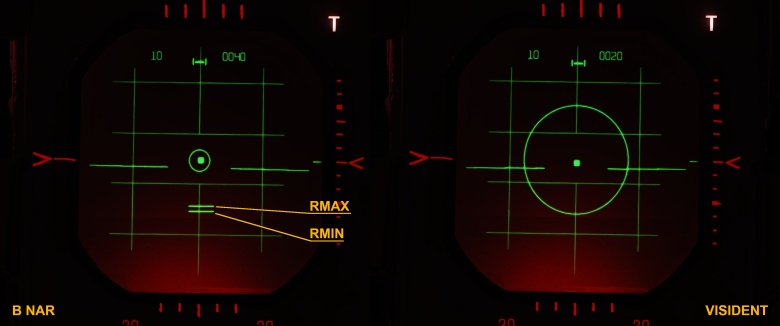Video
Visual Identification Mode
Often called simply “VI”; in real life it was a handy function used in particular cases. Its primary goal was to facilitate and improve the precision of range management from trail formation, thus enabling visual identification or AAR operations at night or in poor visibility conditions.
The base aim dot function performs a series of range-based, fairly complex computations to guide the crew. VISIDENT, instead, is rather simple: it takes over the aim dot for a previously locked target and repositions it to establish Pure Pursuit.
Additional measures are adopted: for instance, weapons employment is barred behind the interlock switch. Other indications, such as the RMAX and RMIN marks, are removed from the radar scope.

A very handy tool used along VISIDENT is the Range Indicator. This gauge allows the crew to finely monitor the range between the Phantom and the target.
Although the Range Indicator also works in B Narrow and B Wide modes, it is in VI mode that it finds its perfect usage. For example, a chat with Vulture, a brilliant former F-4E WSO and SME, confirmed its utility when rejoining a tanker at night or in the clouds.

Aim Dot x VISIDENT
The beauty of DCS is that it is a game. Therefore, it can be played in many ways, allowing to follow procedures to the dot or mix and match, so to speak.
The previous part of this series introduced Aim Dot intercepts as an immediate tool to position the Phantom during an intercept. The Aim Dot logic switched at R max plus 2 nm from collision to transition guidance and right after to lead pursuit. However, lead pursuit is not the most appropriate tool when the goal is performing a conversion, either for VID or rear-quarter missile employment.
Although there are more appropriate but complex means to solve this situation, Aim Dot intercepts are easy to use and apt for ab initio players.
To satisfy the need for a better intercept endgame, VI can be enabled after the transition guidance has created a displacement. At this point, all the crew has to do, is to centre up the dot and adjust speed if necessary.
Example
From low TA / high AA, I started with a turn to increase lateral separation followed by a turn into collision course when the Target Aspect reached circa 40 right or AA 140, thus capturing the aspect. Next, right after the displacement, I switched to VI and simply centred up the dot.
As mentioned, although there are better ways to perform this kind of intercept, whether on a cooperative target or a tanker, this is simple enough and may come in handy, especially to new players.

TacView allows to better appreciate the manoeuvre. If you have watched the previous chapter of this series, the final turn into the target will immediately appear different, whereas the gameplan adopted to create later separation and therefore room for the conversion, is pretty much the same.
This article, along with the previous, has shown tools part of the Phantom’s avionics useful to accomplish various air-to-air tasks. Going forward, the focus will shift towards more methodical approaches and eventually intercepts without a lockon.
